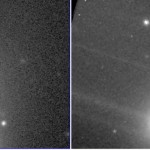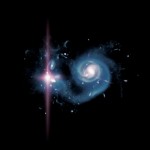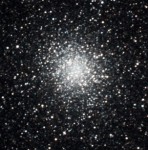W. M. Keck Observatory press release by Dr. Duncan Forbes…
It was a dark and stormy night in the city of Angels. Well, actually it wasn’t. But more on that later…
It was a clear night on the summit of Mauna Kea at Keck Observatory on the 20th March. My colleagues and I were using the Echellette Spectrograph and Imager (ESI) instrument, which looks at faint objects in the visible wavelengths, to study star clusters and small galaxies.

Shortly into our night’s observing, we noticed a bright source in the guide camera image that wasn’t on our finding chart of that region. Still we managed to find our target and took a spectrum of it. But we decided to go back and see if that `new’ bright source was still there. Sure enough it was and it hadn’t moved. It was probably a supernova (or an asteroid coming straight at us!), so I decided to get a 5min spectrum with ESI. And indeed we had found a supernova—a type Ia to be exact. Type Ia supernovae are fairly rare in the nearby Universe and represent the explosion of at least one white dwarf star in a binary system. It is this same type of supernova that led to the discovery of Dark Energy in the Universe using the Keck Observatory, and three Nobel prizes.
Our supernova is located in the outskirts of a galaxy some 100 million light years from us—so it exploded 100 million years ago but the light only reached us that night.
I later found out that an automated telescope on the Palomar Mountain overlooking Los Angeles detected the supernova shortly before us. They also managed to get a spectrum but that was taken after our Keck II/ESI spectrum. The exciting thing is that both the Palomar Observatory and ourselves managed to observe the supernova in the 1-2 weeks before it reaches its maximum brightness (and then fades steadily after that).
The supernova has been given the designation SN2014ai.
All in all, not bad for a late night at the office…
Duncan Forbes is a professor of astronomy at Swinburne University in Melbourne, Australia, and a 2014 Evenings with Astronomers presenter at the signature Friends of Keck lecture series. Swinburne astronomers are awarded time for their research on Keck Observatory through an agreement with the California Institute of Technology.


